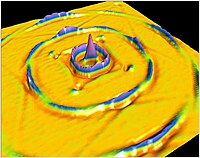
Photo from wikipedia
To achieve high-efficiency acoustic focusing, an artificial periodic acoustic structure composed of two-dimensional three-component cell arrays was used to manipulate the transmission wave fronts of acoustic waves, and the acoustic… Click to show full abstract
To achieve high-efficiency acoustic focusing, an artificial periodic acoustic structure composed of two-dimensional three-component cell arrays was used to manipulate the transmission wave fronts of acoustic waves, and the acoustic field characteristics were numerically simulated by COMSOL finite element software. The results showed that whether the spherical acoustic wave generated by the point excitation source or the planar acoustic wave generated by the linear excitation source was used as the incident wave, an emission focus point can be generated at the top of the acoustic model. The intensity of the acoustic pressure at the focus point depended on the frequency of the incident acoustic waves. Under the same vibration period, the acoustic pressure will increase first and then decrease. It will reach a maximum value at the resonance frequency. In addition, when the model was cut into a right-angled trapezoidal structure with the axis of symmetry as a cross-section, the acoustic wave can produce a variable-direction focusing effect, and the “acoustic levitation” effect can also be realized. This series of anomalous acoustic phenomena can provide a new direction for acoustic directional transmission, acoustic wave detection, and acoustic stealth.
Journal Title: AIP Advances
Year Published: 2019
Link to full text (if available)
Share on Social Media: Sign Up to like & get
recommendations!